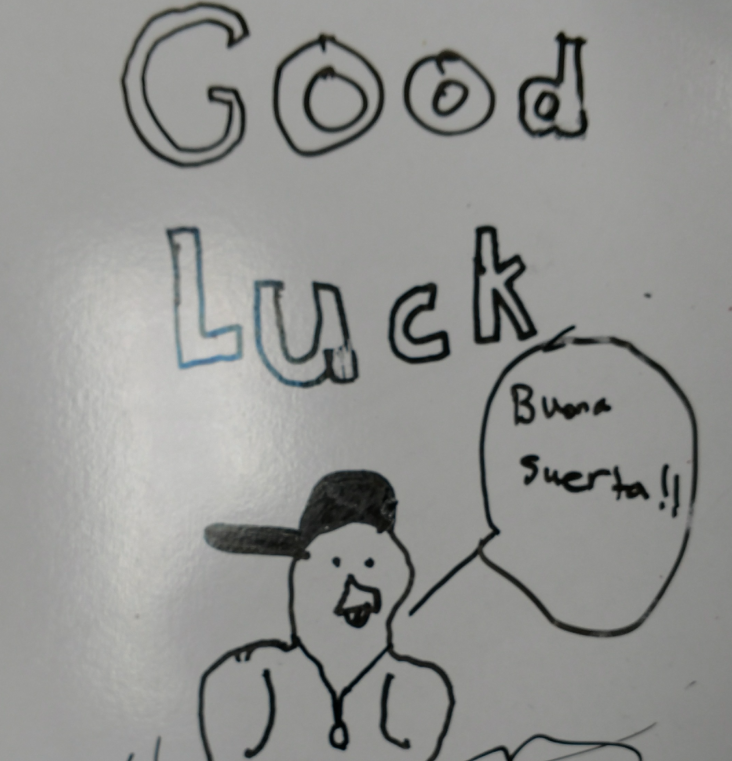Today’s post is a little out of order, but something caught my eye and I wanted to share it with you!!
One of the things we all deal with in the classroom is test anxiety. No matter how much “safety” we have built in, the moment the word “quiz” or “test” pops up (see what I did there? 🙂 ) some of our students just freeze up or freak out.
These ideas won’t necessarily solve the problem, but they will help! Not everyone can do all of these, but if you feel you can’t, ask yourself why. Is it that you really cannot, or is it that it is just outside of what you are accustomed to? Our own “beliefs” about assessment are based on experience, rather than reality….and it’s good to examine them!
So take these ideas seriously, but remember, not all ideas are for everyone!!
1. Don’t test students on things they haven’t “mastered”.
Is that possible? More or less, so let’s strive for more!! Traditionally, even if we don’t like to admit it, language tests have been all about the top students. They have been full of very specific elements and the exceptions rather than the regular. Let’s change that!
If we are teaching towards success, and for proficiency, let’s document what they KNOW and what they CAN DO. (Otherwise we should be writing Can’t Do Statements!!!) Let’s fill up our quizzes and tests with items that allow our students to demonstrate their strengths.
Now, if we need to assess a particular skill or item in order to find out if HOW the students are doing, let’s do a lot of informal assessment. Let’s use that formative assessment to adjust the input we deliver and the interactions we have in class!
EVERYONE acquires their first language without testing, I”m pretty sure that it is NOT a requirement for second language acquisition. If, and when, we are required by the powers that be to formally assess a skill, let’s do it with humor, confidence and joy. Or at the very least make it a part of a larger assessment so that the test is predominantly material they can be successful with!
2. Assess skills as well as knowledge.
This could be an entire course of information on proficiency and assessment grading! So I’ll just say that we need to look at our assessments to see if they actually assess what we think they are. Unfortunately, the easiest assessments to grade are often the least effective at actual assessment. Let’s pledge to continue to work with colleagues and explore ways to assess that don’t suck up large amounts of class time but do allow students to demonstrate what they can do, as well as what they know.
3. Don’t put every assessment in the “book.”
Like many TPRS/CI teachers, I usually only put grades in the book if approximately 80% of the students earned a score of 80% or above. If the class, as a whole, scores poorly, then clearly there was a problem with the assessment or I assessed them too early. I should not be punishing the students for those reasons.
If just a few students do poorly, then I follow the department/school policies for make up tests. And make sure they get what they need if I can!
4. Give students what they need in advance, without giving them the answers.
Giving them the answers is what they say they want, because their experience is that teachers want very specific answers. Is that what we want? I don’t think so. Not on most assessments anyway. So let’s provide our students with materials that fill that need to have “answers” to prepare for…at least just a little bit.
A. Short lists, in paper form or on sites like Quia where students can “practice” will fulfill some of that need and lessen anxiety for students, parents and colleagues. They don’t have to be required, but they can be if that fits the needs of your situation.
B. Readings, and listenings, are their best gift. Anything that you do in class that can be put on line or in print form for them to use as a resource is also a gift. Of course, we don’t always have time for that, but if you have access to upper level students (they don’t have to be yours!) or cooperative heritage speakers, take advantage of their abilities to help you to prepare these materials.
C. Show them the format in advance. Not because they need it to do well, but so that they are not stressed when they see it.
D. Give assessment “structure” they can count on. We have lots of routines in the classroom. Let’s consider “testing” routines. Here are the ones I used in my deskless classroom in the last two years:
1. An assessment every Thursday. Sometimes very short, sometimes longer. I may or may not have told them in advance what would be on it, but they did know the format. It could be reading/listening (illustrate, fill in the blank questions, English questions, Spanish questions, open-ended questions, etc.) or writing (free write, structured writing, response writing) They also knew how it would be graded.
Confession: I needed to schedule assessments or I would forget to do them. Occasionally I would just call an assessment-free week and I could, because I knew that I already had enough in the book!
2. Students arrived to find a good luck message on their seats. Check this out!

Students could, if they wanted to, take a quick picture of the message before erasing it to prepare for the quiz.
3. Students picked up a “good luck duck” if they wanted to. I had a collection of tiny plastic ducks that students could have by their side during tests and quizzes. The Patitos were very popular!

(These are from Oriental Trading company..click on pic…which is where I got mine.)
4. After our daily start routine, I would announce the assessment and ask student to find a spot to take their quiz. Because we were deskless, they were allowed, within reason, to go to a different part of the room to take assessments. During this time, students were allowed to talk quietly, make sure they had a whiteboard/marker and borrow a writing utensil if needed. (I only allowed a couple of minutes for this!)
5. I used one of our call and response signals to quiet the group.
6. Tests were passed out FACE DOWN AND KEPT FACE DOWN. If the test had two sides, they put it under their whiteboards. I reviewed and reinforced this all year!!
7. When everyone had a test, then, we all took three deep breaths together and turned them over together. Everyone put their name on the paper at the same time. Then, I went over the instructions, asked questions to make sure that they understood the instructions and let them ask questions about the instructions. (Middle school, remember?!)
8. Students began the assessment. When they were finished, they answered the quiz question (see below) that was on the paper or the screen/board. (See below)
9. When that was finished, students either handed me the paper or raised their hand for me to collect (depended on the group!!). Either way, I looked over EACH paper as it was turned in to make sure that it was complete. If not, I could have a short conversation with that student to encourage/support finishing it. I also checked to see if their name was on it! (Middle school, remember?!)
10. Students then created a good luck note for the next class on their white boards.
11. If students are still testing, those who have finished their tests found a book in our FVR collection to read.
12. When all tests are turned it, I played a favorite, upbeat song and everyone returned to their regular seats for the next activity!! (Often a brain break!)
This routine looks long on paper, but it wasn’t and it solved many, many, many potential problems!
E. Connect with a Question:
For years my colleague Karen and I have suggested the sharing space at the end of the quiz. We know that a lot of you already do it. It’s a wonderful way to catch a moment with each student. Leave a section a the end of each assessment where you can do any of the following:
1. Ask a question (L1 or L2….to be answered in any way you prefer…I usually ask for answers in L1 but encourage and celebrate all answers in L2!)
Some ideas:
What was the best part of your week?
What are you looking forward to this weekend?
What nice thing did you do for someone this week?
Name two places you want to go to in your lifetime.
Who do you look up to and why?
What makes you laugh?
Who is your favorite Youtube star?
Tell me the name of a show/song/book I need to see/hear/read.
2. Ask for a drawing. It could be something you can use to intro the next lesson, or simple a random “Draw me a picture.”
3. Ask for feedback on the test, the week, whatever!
4. Take a poll: What Friday activity do you want to work for?
Do we need a seating chart change?
Etc.
F. Assess with confidence, joy and humor!
It’s pretty difficult to change a mindset that has been years in the making, but it’s worth a try! So many of our students are “test-stressed” that anything we can do to lessen their anxiety is a gift, to them and to our entire community.
So don’t be afraid to make it fun!! Use humorous pictures for writing prompts and humorous stories for reading. Put one or two totally ridiculous, or class-related answers in the multiple choice options. (It’s a great sneaky way to check comprehension….if they laugh, they understood!)
Celebrate with words! Say OUT LOUD when you are proud of how they approached an assessment, did their best, etc. If we can remind them that it is their attitude that can make the biggest difference, it will become easier for them to believe it!!
I love to use music to “end” an assessment. Let them sing! Let them use percussion instruments (if you dare). Let them gesture! Let them dance! Go back to the joy any chance that you can! (Even if they pretend they are too sophisticated for it!)
This turned out to be a bit longer than I planned. It isn’t your typical assessment post, but I hope that it solves some problems for you!
Oh….I almost forgot! Here is what caught my eye. I would love to have kids use these, but only on tests!

(I found these on Zulily…click on pic)
with love,
Laurie










